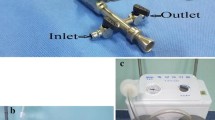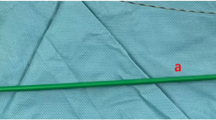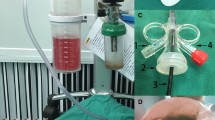Abstract
The purpose was to do a study to compare infectious complications in patients operated for MiniPerc or Minimally invasive Percutaneous Nephrolithotomy (MPCNL) using MIP and MPCNL with suction using Shah Superperc sheath for medium-sized renal stones less than 3 cm in size. The primary objective of this study is to compare the infectious complications and the secondary objectives are to compare stone-free rates, complication rates and operative times. A prospective randomized controlled trial with patients having proximal ureteral and renal stones of 10–30 mm size and planned for MPCNL done at a single institute. A total of 80 consecutively admitted patients with written informed consent were included for randomization with 40 patients in each arm of MPCNL and suction MPCNL. The median age in MPCNL and suction MPCNL arms were 48 and 49 years, the median stone size of 15.45 and 16.7 cm, the Median stone volume of 1576.2 vs 1752 mm3, and the median stone density of 1258 and 1250 Hu, the median hospital stay of 3 days in both arms were comparable. Infectious complications were comparable in both arms. Operative time was significantly less in the suction MPCNL group (26.5 min–IQR 17–34.8) than in the MPCNL group (34.8 min–IQR 20–45), p = 0.021 and stone-free rates (SFR), were more in Suction MPCNL arm 97.5% than in MPCNL 87.5%, p = 0.04. Overall, the complication rates were comparable in both arms. Suction MPCNL procedure resulted in shorter operating times and more SFR than conventional MPCNL with comparable complication rates.

Similar content being viewed by others
Data availability
The datasets generated in the current study are available from the corresponding author upon reasonable request.
Abbreviations
- MPCNL/miniPCNL/MiniPerc:
-
Minimally invasive percutaneous nephrolithotomy
- EAU:
-
European Association of Urology
- PCNL:
-
Percutaneous nephrolithotomy
- Fr:
-
French
- G:
-
Gauge
- MIP:
-
Minimally invasive PCNL system
- UTI:
-
Urinary tract infection
- HU:
-
Hounsfield units
- CT:
-
Computed tomography scan
- TFL:
-
Thulium fiber laser
- W:
-
Watts
- J:
-
Joule
- Hz:
-
Hertz
- SP:
-
SuperPulse
- DJ stent:
-
Double J stent
- NCCT:
-
Non-Contrast CT
- SOFA:
-
Sequential-sepsis-related- organ failure assessment
- IRB:
-
Institutional Review Board
- EC:
-
Ethical Committee
- CONSORT:
-
Consolidated standards of reporting trials
- RCT:
-
Randomised controlled trial
- DM:
-
Diabetes mellitus
- HTN:
-
Hypertension
- IHD:
-
Ischemic heart disease
- IQR:
-
Interquartile range
- PCN:
-
Percutaneous nephrostomy
- SFR:
-
Stone free rate
- IRP/IPP:
-
Intrarenal pressure/intrapelvic pressure
References
EAU Guidelines on Urolithiasis—GUIDELINES—Uroweb. Uroweb - European Association of Urology. https://uroweb.org/guidelines/urolithiasis/chapter/guidelines
Ruhayel Y, Tepeler A, Dabestani S, MacLennan S, Petřík A, Sarica K et al (2017) Tract sizes in miniaturized percutaneous nephrolithotomy: a systematic review from the European association of urology urolithiasis guidelines Panel. Eur Urol 72(2):220–235
Lopes T, Sangam K, Alken P, Barroilhet BS, Saussine C, Shi L et al (2011) The clinical research office of the endourological society percutaneous nephrolithotomy global study: tract dilation comparisons in 5537 patients. J Endourol 25(5):755–762
Kukreja RA (2018) Should mini percutaneous nephrolithotomy (MiniPNL/Miniperc) be the ideal tract for medium-sized renal calculi (15–30 mm)? World J Urol 36(2):285–291
Giusti G, Piccinelli A, Taverna G, Benetti A, Pasini L, Corinti M et al (2007) Miniperc? No, thank you! Eur Urol 51(3):810–814
Wu C, Hua LX, Zhang JZ, Zhou XR, Zhong W, Ni HD (2017) Comparison of renal pelvic pressure and postoperative fever incidence between standard- and mini-tract percutaneous nephrolithotomy. Kaohsiung J Med Sci 33(1):36–43
Zanetti SP, Boeri L, Gallioli A, Talso M, Montanari E (2017) Minimally invasive PCNL-MIP. Arch Esp Urol 70(1):226–234
Nagele U, Horstmann M, Sievert KD, Kuczyk MA, Walcher U, Hennenlotter J et al (2007) A newly designed amplatz sheath decreases intrapelvic irrigation pressure during mini-percutaneous nephrolitholapaxy: an in-vitro pressure-measurement and microscopic study. J Endourol 21(9):1113–1116
Mager R, Balzereit C, Gust K, Hüsch T, Herrmann T, Nagele U et al (2016) The hydrodynamic basis of the vacuum cleaner effect in continuous-flow PCNL instruments: an empiric approach and mathematical model. World J Urol 34(5):717–724
Zeng G, Zhu W, Lam W (2018) Miniaturised percutaneous nephrolithotomy: Its role in the treatment of urolithiasis and our experience. Asian J Urol 5(4):295–302
Alsmadi J, Fan J, Zhu W, Wen Z, Zeng G (2018) The influence of super-mini percutaneous nephrolithotomy on renal pelvic pressure in vivo. J Endourol 32(9):819–823
Shah K, Agrawal MS, Mishra DK (2017) Superperc: a new technique in minimally-invasive percutaneous nephrolithotomy. Indian J Urol IJU J Urol Soc India 33(1):48–52
Seitz C, Desai M, Häcker A, Hakenberg OW, Liatsikos E, Nagele U et al (2012) Incidence, prevention, and management of complications following percutaneous nephrolitholapaxy. Eur Urol 61(1):146–158
Xu G, He Y, Zhao H, Jiang X, Feng G, Yang W et al (2016) Mini-nephroscope combined with pressure suction: an effective tool in MPCNL for intrarenal stones in patients with urinary tract infections. Urolithiasis 44(5):445–450
Lievore E, Boeri L, Zanetti SP, Fulgheri I, Fontana M, Turetti M et al (2021) Clinical comparison of mini-percutaneous nephrolithotomy with vacuum cleaner effect or with a vacuum-assisted access sheath: a single-center experience. J Endourol. 35(5):601–608
Lai D, Chen M, Sheng M, Liu Y, Xu G, He Y et al (2020) Use of a novel vacuum-assisted access sheath in minimally invasive percutaneous nephrolithotomy: a feasibility study. J Endourol 34(3):339–344
Du C, Song L, Wu X, Fan D, Zhu L, Liu S et al (2018) Suctioning minimally invasive percutaneous nephrolithotomy with a patented system is effective to treat renal staghorn calculi: a prospective multicenter study. Urol Int 101(2):143–149
Zhu Z, Cui Y, Zeng H, Li Y, He C, Chen J et al (2019) Suctioning versus traditional minimally invasive percutaneous nephrolithotomy to treat renal staghorn calculi: a case-matched comparative study. Int J Surg Lond Engl. 72:85–90
Huang J, Song L, Xie D, Li M, Deng X, Hu M et al (2016) A Randomized study of minimally invasive percutaneous nephrolithotomy (MPCNL) with the aid of a patented suctioning sheath in the treatment of renal calculus complicated by pyonephrosis by one surgery. BMC Urol 16(1):71
Singer M, Deutschman CS, Seymour CW, Shankar-Hari M, Annane D, Bauer M et al (2016) The third international consensus definitions for sepsis and septic shock (Sepsis-3). JAMA 315(8):801–810
Dindo D, Demartines N, Clavien PA (2004) Classification of surgical complications: a new proposal with evaluation in a cohort of 6336 patients and results of a survey. Ann Surg 240(2):205–213
Somani BK, Desai M, Traxer O, Lahme S (2014) Stone-free rate (SFR): a new proposal for defining levels of SFR. Urolithiasis 42(2):95
Assel M, Sjoberg D, Elders A, Wang X, Huo D, Botchway A et al (2019) Guidelines for reporting of statistics for clinical research in urology. J Urol 201(3):595–604
Schulz KF, Altman DG, Moher D (2010) CONSORT 2010 statement: Updated guidelines for reporting parallel group randomised trials. J Pharmacol Pharmacother 1(2):100–107
Xu G, Liang J, He Y, Li X, Yang W, Lai D et al (2020) Comparison of two different minimally invasive percutaneous nephrostomy sheaths for the treatment of staghorn stones. BJU Int. 125(6):898–904
Zhong W, Zeng G, Wu K, Li X, Chen W, Yang H (2008) Does a smaller tract in percutaneous nephrolithotomy contribute to high renal pelvic pressure and postoperative fever? J Endourol 22(9):2147–2151
Acknowledgements
No additional acknowledgements.
Funding
No funding was received for conducting this study.
Author information
Authors and Affiliations
Contributions
Dr NP: protocol/project development, manuscript writing. Dr SA: data collection; Dr AP: data collection; Mr NS: data analysis; Dr AS: manuscript editing and review; Dr AG: manuscript editing and review; Dr RS: manuscript editing and review; Dr MD: manuscript editing and review. The manuscript has been read and approved by all the authors, the requirements for authorship have been met and each author believes that the manuscript represents honest work.
Corresponding author
Ethics declarations
Conflict of interest
The authors declare that they have no conflicts of interest.
Ethics approval
The study was done as per the Good Clinical Practice Guidelines and as per the Guidelines in the Modified Declaration of Helsinki. Informed and written consent was obtained from all the participants. The protocol approval was obtained from the Institutional Review Board before study commencement (IRB No 15/2022) and the Ethical clearance was obtained from the Institutional Ethical Committee (841/2022).
Consent to participate
Informed written consent was obtained from all individual participants included in the study.
Consent for publication
Patients signed the informed written consent regarding publishing their data and photographs.
Additional information
Publisher's Note
Springer Nature remains neutral with regard to jurisdictional claims in published maps and institutional affiliations.
Rights and permissions
Springer Nature or its licensor (e.g. a society or other partner) holds exclusive rights to this article under a publishing agreement with the author(s) or other rightsholder(s); author self-archiving of the accepted manuscript version of this article is solely governed by the terms of such publishing agreement and applicable law.
About this article
Cite this article
Pathak, N., Agrawal, S., Parikh, A. et al. A randomized controlled trial comparing infectious complications using mini perc with and without suction for renal stones less than 3 cm in size. Urolithiasis 52, 6 (2024). https://doi.org/10.1007/s00240-023-01487-7
Received:
Accepted:
Published:
DOI: https://doi.org/10.1007/s00240-023-01487-7




